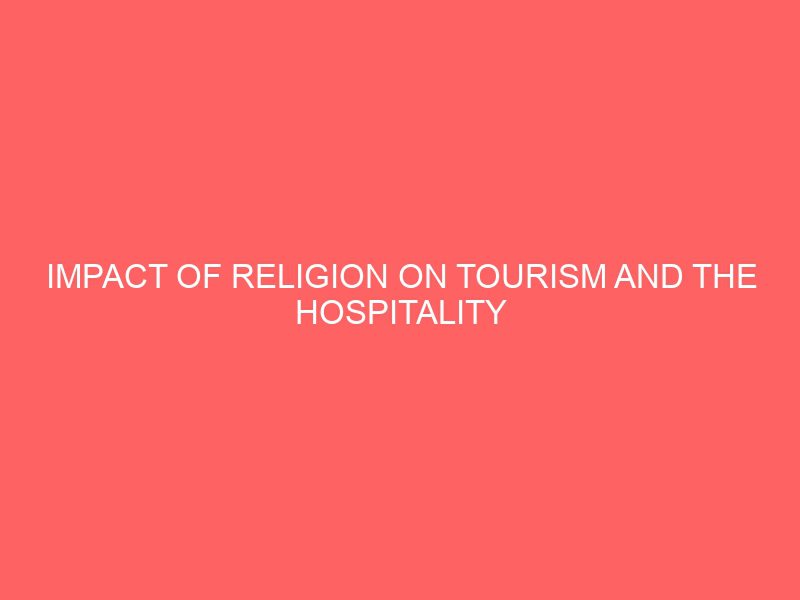Description
ABSTRACT
This project was written in compliance with the instruction given by the Federal Polytechnic Ede this project would be of immense value to those willing to know more about religion, tourism, and the Hospitality industry. Also, the impacts which religion has on the society and tourism, the significance of religion tourism, and some religion festivals were discussed based on its relationship with the hospitality industry.
CHAPTER ONE
1.1Introduction
Tourism according to MCINTOSH and Gupta 1977 as any voluntary activity that temporarily takes person away from his or her usual place of residence in order to satisfy a need either for pleasure, excitement, experience or relaxation. Tourism many be seen to consist senses of encounter in which visitors interact with their hosts.
The history of tourism could be traced back to the days when Jesus Christ was born. The birth of Jesus Christ which inside the three wise men to journey, from the east of Jerusalem to king to visit Jesus Christ with different gifts. Mathew chapter 2 The holy bible, Tourism is said to be Gods own given gift to man, in the sense that any tourist attraction centre is beautiful, thrilling and a marvellous sight to behold which will leave you thinking of Gods great kindness to man.
Religion according to Socrates a greek philosopher, 1912 is defined as the practise that depicts the belief of people which are of more importance to their everyday life. It controls the laws, how you think and act, what you believe in, value etc. This have led to a dramatic increase in knowledge about their cultures, norms and also the establishment of economic and social histories of progress.
History has it that the stating point of religion was from the tribal band whose religion is amonistic and involved shamans a medicine man from a similar region and totems an object; species, plant, natural phenomenon symbolising a family. Since the group was tribal, there was no permanent sanctuary for worship with cultic rites centre on identification with wild animals and appeasing spirits of the hunted animals.
Hospitality industry, an aspect of Tourism which cannot be overlooked is defined according to the prospectors act 1956. section 1 3 as an establishment held our by the proprietors offering foods and drinks if so required sleeping accommodation without special contract to any traveller presenting himself to be in a fit state of mind to be received and is willing and able to pay for the services rendered to him by the establishment. Its history can be traced to the early civilization of the mind 16th century when the Romans built roads between the main cities and towns of the time along which posting houses known as stabuli were set up to provide holding, food drinks. Thus, Every city/town at this time had ale houses which provides only drink which later advanced to the building of what we now call the hospitality industry hotel.
Therefore, as stated above, tourism religion and hospitality cannot separated from one another which means that the impacts one has on the other cannot be underemphasised.
1.2Background of the Study
The background of the study focused on the surrounding the situation i.e. the course of study and how the issues effect the followers of such religion moreso, it will focus on the activities at the place of worship, likes for the leaders and some moral acts that encourage people from religions activities. This study help to unveil the impacts that tourism has on religion and hospitality industry.
Tourism and its associated practices interact with religious life and the institutions of religion in virtually every corner of the world. From Amish communities of rural Pennsylvania to the snowy summits of Mount Fuji in Japan, from the mysterious ruins of Machu Picchu in the Peruvian Andes to the monumental pyramids of Giza in Egypt, from Chartres in France to the Western Wall in Jerusalem, millions of tourists seek out places of religion every year. The relationship between religion and tourism, however, amounts to far more than places of religion that host tourist visitors. In fact, there are at least three broad approaches to understanding this relationship: spatial, historical, and cultural. Each of these illuminates different implications for religious life when tourists enter a sacred precinct.
1.3 HISTORICAL BACKGROUND OF ADO EKITI
The first thing to note is that Ado is the name of a political society, as a matter of fact, a kingdom, on account of its size and development, was the largest in Ekiti. In its heydays, the kingdom covered all of the presentday Ado Ekiti Local Government Area, Irepodun/Ifelodun and Aiyerire Local Government Areas, Ekiti Southwest less Ogotun and part of Ido/Osi Local Government Area. Traditions assert that at the height of its power in the 18th and 19th centuries, about 200 years ago, Ado kingdom consisted of 150 ewadojo communities. The metropolis of the kingdom was AdoEkiti, Ewi was the sovereign head, his palace was and still is situated in the Chief city. All the high Chiefs lived in the city. These Chiefs were patron Chiefs of all the subordinate towns and villages.
Some Past Traditional Rulers Ewi Adewumi Agunsoye 1910 1936 Ewi Anirare Aladesanmi II 1937 1983 Ewi Adeyemi George, Adelabu I 1984 1988 Ewi Adeyemo Adejugbe, Aladesanmi III From 1990 up to the present time
1.3.1 HISTORY
Where AdoEkiti is situated is a land that has been continuously inhabited/occupied by human communities from time immemorial. Available research shows that human societies of unknown antiquity occupied this neighbourhood about 11,000 years ago. These ancient inhabitants were probably the same or progenitors/ancestors of Igbon near Ogotun, Erijiyan, Ijero, Ulesun and Asin near Ikole who were probably autochthones because available traditions shows that they had lived in and near their abodes from time immemorial. As a matter of fact, no one knows where, if any, they came from and for how long they had lived in those ancient sites. Ulesun appears the most wellknown apparently on account of its size, the number of its subordinate communities especially Aso, Ulero, Isinla, Ilamoji, Ukere and Agbaun near Igbemo, its wellorganized traditional religion including its festivals etc and its location at the heartland of Ekitiland. These ancient people were the ancestors of Ekiti, they played hosts in the 7th and 8th centuries, about 1,200 years ago, to waves of immigrants from the basins of the rivers Niger and Benue; these settled among the ancient Ekiti, and were fewer in number and so, the hosts culturally absorbed them. Eventually,the people fused as aboriginal people by and by.
After many generations, a new wave of immigrant groups penetrated this homeland; their leader as Ewi, second succesor of Prince Biritiokun, Son of Oduduwa, on account of his wanderings all the way from the Benin forests, the leader was nicknamed Awamaro. Ulesun people welcomed them warmly and neighbouring committes came together to assist their settlement built homesteads for them at OkeIbon in Odo Ijigbo. Eventually, Ewi and his people overthrew the existing political arrangements, conquered Ulesun community, displaced its ruler Elesun and established a new town, Awamaro named Ado, meaning here we encamp. Ewi Awamaro and his successors conquered villages and cottage in the neighbourhood, replaced their rulers with thier own loyalists, stalwarts and scions of the royal family. The important citizens of these conquered communities were relocated in Ado. Ewi supplanted Elesun as sovereign ruler of the aboriginal and settler population, many of Elesuns Chiefs were confirmed in their offices but they swore oaths of allegiance to the Ewi. Many of the succeeding Ewi expanded the kingdom by force of arms, annexed territories and gave these territories to scions of the royal families, these assumed titles which became hereditary.
The expansion and growth of AdoEkiti and the kingdom of Ado lasted over 400 years. In the course of this expansion, Ado became associated with certain traits. Citizens of the kingdom in general and those of the mother town, AdoEkiti in particular were reputed for great attention to cleanliness. A popular lyrical description of Ado citizenry depicts:
Ira Ule Ado metipise fifin seree Ado citizens with their usually clean heels
Ado people were, by local standard, tough and brave warriors. Traditions preserve numerous brave citizens of each Ado community, the best known were Ogbigbonihanran of Idolofin quarters, Ogunmonakan of Okelaja, Fasawo, a.k.a Aduloju of Udemo quarters, and Eleyinmi Orogirigbona of Okeyinmi quarters all of AdoEkiti and Ogunbulu, a.k.a Ala loju Osoru of Aisegba. The exploits of Ado tough in many parts of Ekiti formed the basis of the popular orature:
Ikara seji sinu agbagba temi ukoko Of two balls of cake in the fryingpan, he insists his share is one
Folk, traditions are replete with fond references to Ewis relationship with some other Ekiti traditional rulers. Ewis antecedents are depicted as:
Elempe Ekiti mightiest man in Ekiti On kemu kan o mu meji Oloju kenu kan gba kete re He is entitled to one, he took two he has a disposition to take everything Ewi i pe mi udiroko Onitaji i pe mi esunsu…… Ewi invites me for his udiroko festival Onitaji invites me for his esunsu festival
Folk traditions of this nature vividly portray the towering position of AdoEkiti. In the first place, AdoEkiti is situated at the heartland of Ekiti and is thus less exposed to crossborder attacks or nonEkiti influences. Consequently, over many centuries, waves of immigrant groups seeking haven settled in AdoEkiti and several other Ado communities. Many of these immigrants were refugees, they left thier old homelands in parts of Ekiti, Akoko, Owo etc. where their leaders lost out in chieftaincy contests. Some were war captives, these were brought in droves by Aduloju and his lieutenants from their slave wars of the 1870s and 1880s in parts of Owo, Ose and Akoko. They were settled in Ado communities where they increased the local population, and enriched the culture with thier lineage names and festivals in similar circumstances, citizens of Ado communities left their fatherland and settled in a few places in the neighbourhood up to Ijesaland. Ibadan sacked many Ado communities in 1873 and made a huge haul of prisoners of war and other captives who eventually settled in Iwo, Ibadan and some Remo towns such as Iperu and Makun Sagamu. However, Ado communities especially the mother town offset part of their losses with a large number of slaves and prisoners of war from Owo, Ose and Akoko.
From the 1880s, agents of the British, especially Christian missionaries penetrated the Yoruba interior in an endeavour to end the wars, in particular, the wars of liberation Ekitiparapo communities waged against Ibadan since October, 1879. In June, 1886, politicalcummilitary officers got the belligerent parties to sign a truce and in March, 1893, Governor Carter of Lagos visited Ibadan and Ekitiparapo camps of Igbajo and ImesiIle and terminated the war, got the leaders to sign treaties which prohibited slavery and slave trade, human sacrifices and the use of weapons to settle conflicts. The British administration in Lagos which had authority over Yoruba interland from 1893 proclaimed a general emancipation for slaves and ordered slaves who so wished to return to their former homelands. As a result, numerous citizens of Ekiti in general and Ado in particular returned from captivity forth with. The British established its colonial rule on vast territories and in 1900, a number of districts became Nigeria. Eventually, further reorganizations led to the creation in January, 1913 of Ekiti District, with headquarters in AdoEkiti. That was a landmark from where to begin the discussion of today, modern times, a period characterized by the emergence of new things, phenomenal growth and development of old kingdom and its Chief city, AdoEkiti.
1.3.2 RELIGION
Among the most conspicuous of the great changes were the introduction and expansion of Christianity and Islam. Christian missions especially of the CMS, Roman Catholic, Baptist, African Church and Methodist, later the Cherubum and Seraphim and Apostolic Church took root and expanded during the 20th century. Each of these Christian communities established numerous churches such that by 1970, the CMS Anglican and the Roman Catholic had grown so fast that they had become dioceses with their headquarters and seats of bishops in AdoEkiti. The two missions had three grammar schools, the number increased to five in 1990. The growth of Christian communities was very rapid between 1970 and 2000; new missions and denominations Pentecostal, Charismatic, Evangelical and Episcopal arose, swelling up existing communions. Altogether over one hundred churches were recorded in the city in the year 2000.
The Muslim community did not lag behind, the faith spread. The central mosque was built about 1930 and thereafter, a number of mosques were built in Idemo, Umayo, Isato Irona, Ogbonado, Okesa, OkeIla etc. The AnsarUdDeen emerged in the early 1940s. As a matter of fact, the number of mosques and the number of Muslims who have performed the Hajj can readily come to hand as indices of expansion. The number of mosques increased substantially with the growing number of welltodo muslim who build mosques as annexes to their private homes; by the year 2000, more than forty mosques could be counted in the city. By 1960, only Alhaji Akorede had performed the Hajj but the number of Alhajs increased in the 1970s and steadily increased in the 1980s and 1990s.
1.4Objective of the Study
The study is aimed at find out how to develop tourism globally and also aimed at looking into the various impacts of religion on tourism and hospitality industry.
It is hoped that through this study, tourists would have better understandings of religion and its impact on tourism and hospitality industry as a whole. It is also hoped that through the findings in this study, people tourists would see the relevance of Tourism on Religion.
1.5 RESEARCH QUESTIONS
The researcher framed some sample question which through it will enable the researcher archive the objective of this study. The research question are as follows.
Are there any motivation for people to embark on tourism
Does religion motivate people to embark on tourism
Does religion have an impact on tourism and hospitality industry
Are there any relationship between religion tourism, and the hospitality industry
Does government participate in the development of religion
Does Religion motivate people to travel
1.6Significance of the Study
The significance of the study is based on the fact that if findings of the researcher s are well implemented, it will facilitate and improve the development of Religion towards tourism. It is hoped that this study would answer some questions of what impacts religion have on hospitality and tourism industry. The study will also arouse researchers investigate ways of improving Religion Tourism.
1.7Statement of Problem
These are the problems encountered during the course of engaging on the religion tourism activities. The major problems include insufficient disposable income to partake and enjoy the various religious activities, transportation problems, accommodation and food and beverages services, and the major things that affects tourist from engaging in the religion tourism.








Agueda –
Thanks